After deciding to visit a few wildcat Jewish settlements in the West Bank, I felt anxious. Will they recognize us for the Tel Aviv leftists that we are? Will they become enraged at our questions? Might we face violence? Arriving at the settlement gate, however, I am struck by just how much the place resembles the kibbutz I lived on just a few years ago. But by the end of our journey, it becomes clear that we are not welcome.
By Edo Konrad
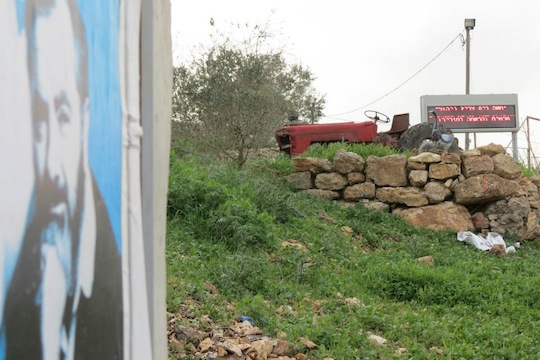
The first and only time I had ever spoken to an ideological settler was during the summer 2011 social protests. Out on Rothschild Boulevard in the heart of Tel Aviv, where thousands of Israelis gathered to demand social justice, I argued face-to-face with a teenage settler boy. It was on the same day that former MK Michael Ben-Ari arrived with henchman Baruch Marzel and a group of hilltop youth wearing shirts that read “Let the Jews win!” and “Keep Tel Aviv Jewish.” They were there to establish the “Judea and Samaria Tent,” whose main mission was to demand increased government spending on settlement construction and to ensure that the settlement issue was on the protest’s agenda.
“Why are you here?” I asked the boy curiously. To me, a group of people who actively call for taking even more Palestinian land are not allies in my struggle for social justice. His response was frank: “We’re here because we want to make sure that all sectors of Israeli society are represented, not just residents of Tel Aviv. We believe the residents of Migron are no less important, even if the government doesn’t give a shit about them.” The Arabs are the real occupiers of Jewish land, some of the others yelled.
I left Rothschild angry. I was angry with this group of people whose whole raison d’etre seemed to be to make life hell for the Palestinians. But I also began to realize how little I actually knew about them. Growing up in a tightly knit Israeli community in the United States, the settlements and the occupation were entirely absent from any conversation having to do with Israel. It wasn’t until a few years ago when I took a tour of East Jerusalem and the Ma’aleh Adumim settlement that I began to grasp what had been hidden from me for my entire life. Despite my anger, I couldn’t write the settlers off. They were as much a part of this place as any other group, and I needed to meet them. I made a decision to do so not as enemies on Rothschild Boulevard, or as a leftist from my soapbox, but on their own terms, where they live.
A year and a half later, on a rooftop in the heart of Jaffa, I proposed the idea to my friend and fellow +972er Yuval Ben-Ami. We didn’t wait very long, and two days later we set out on our journey.
Hidden from view
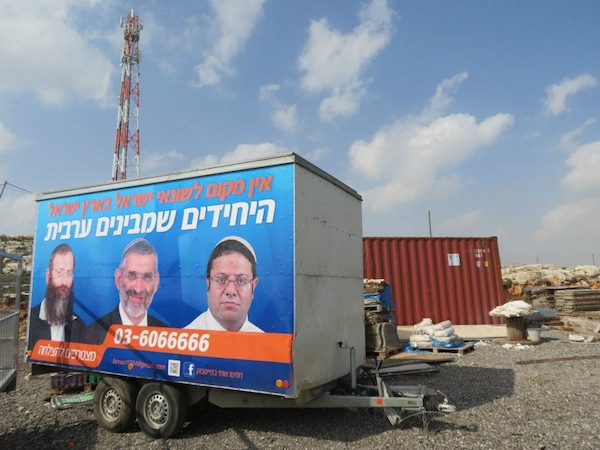
Yuval and I head out on a clear, sunny morning on Bus 86 from Tel Aviv to the settlement of Ariel, where we plan on catching a ride to Yitzhar, an established settlement in the northern West Bank with a history of incitement and violence against neighboring Palestinian villages. I’m feeling anxious, playing out possible scenarios in my head. Will they recognize us for the Tel Aviv leftists that we are? Will they become enraged at our questions? Might we face violence? Have settlers ever killed Israeli leftists, or is there a rule that Jewish blood is pure, thus assuring no violence will come our way? Yuval quells my fears. He is a seasoned traveler, and assures me that, after all, we are simply coming to meet and talk to people, not provoke them.
We don’t feel the Green Line as we drive into the West Bank. A lone checkpoint is all that separates this place from where we were just minutes before. Yuval sings Australian protest songs on the bus, while I laugh anxiously and clutch at my stomach. “You’re going to be fine,” I tell myself.
We get off at the entrance to Ariel and immediately hitch a ride with an elderly man from the nearby settlement of Kedumim. A classic Arik Einstein song plays on the radio, imbuing the ride through the valley dotted by red-roofed settlements and sprawling Palestinian villages with an eerie sense of normalcy. The driver says he cannot take us far as Yitzhar, but that he will drop us off at the nearby settlement of Kfar Tapuach, a town known to Israelis as the former home of Meir Kahane, a fanatical settler leader whose party was banned from the Knesset in 1988 for inciting racism against Palestinians, as well as the place where his followers train attack dogs to “prevent the next terror attack” [Hebrew].
But as we arrive at the settlement gate, I’m struck by just how much the place resembles the kibbutz I lived on a few years ago. We walk through the dusty main road to the local park where we meet Racheli and Adina, two young mothers who greet us with friendly smiles as their children play nearby. Racheli, who spoke to us in a mix of Hebrew and English, and who moved to Tapuach from Canada a few years back, recounts the difficulties of making aliyah and acclimating into Israeli society. “Everything is difficult here, everything!” she exclaims. “It’s crowded and everyone is always in your business, and the worst part is the way their parents dress their children!” Racheli and Adina tell us that Tapuach is generally very “normal” but that there is one family at the edge of the settlement that lives without electricity and rides around on donkeys – that’s the family we must talk to.
After a 20-minute hike past a guard tower, the resident security guard and a barbed wire fence that surrounds the settlement and separates it from the neighboring Palestinian village of Yasuf, we finally make it to Seter HaMadrega – the new outpost-neighborhood of Kfar Tapuach. As opposed to Tapuach, where families live in nearly identical red-tiled houses, the residents of Seter HaMadrega live in caravans, with unpaved roads and handmade sanitation systems. The place feels deserted, and apart from the chained dogs that guard most of the makeshift homes, and a few workers, there is no one in sight.

At the bottom of the hill we find the man we’re looking for. Reuven greets us outside of his wooden cabin home, surrounded by what look like manmade structures built of stone, a big pool, a chicken coop and five barking canines that terrify me but have little effect on Yuval. Reuven is alone with his two sons, both of whom have astonishingly long biblical names, and without hesitation, graciously welcomes us into his home. He, his wife, and their two sons all live in the only real room in the house – a dusty, cavernous place where children’s games are strewn across the floor and the shelves are lined with books on the history of the Land of Israel, healthy organic eating, yoga techniques and holy texts. Hippies, I thought.
Almost everything in Reuven’s home is handmade. He built it himself, and decided to call the place Trashei Pereh (“wild rocks”), explaining that settlers often name their new homes after what they envision the place will become (ie. Sha’rei Tikva, or “gates of hope”). For him, it was just the opposite – he named his home in the hopes that it would mold its residents. We tell Reuven that we are journalists who are wandering around in the area and are looking to meet interesting people. He answers all of our questions. He’s friendly, smiles a lot, and never raises his voice. Neither his tone nor his choice of words is diplomatic. Even as he tells us that his dream is to one day conquer the Gilead Mountains and establish a Jewish kingdom across Jordan (“both banks of the Jordan River”), he does so with a hint of playfulness, as if to see how we’d react to what sounds completely absurd to our ears.
For Reuven, the “conflict” is not about hating “the Arabs,” but rather is an eternal war in which the Jews must come out victorious in order to remain where they are. Yuval asks about the prospects for a resolution. “This war has been going on for thousands of years. Perhaps one day he will have to fight in it too,” he answers, nodding at his son who is busy smashing banana after banana into his mouth.
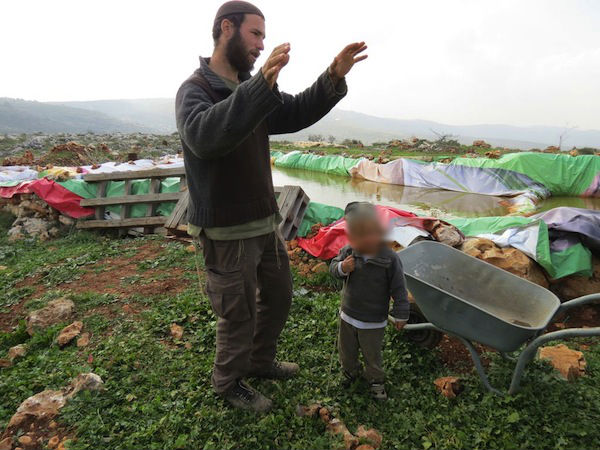
“And what about your Palestinian neighbors?”
“We don’t have any problems with them, except during the olive harvest season. It is then when clashes take place, and then, you know, the police and the army and the Europeans come.” I suddenly understood. Reuven doesn’t harbor a violent hatred toward Palestinians. To him, they are people who simply exist in the background of the story of Jewish national sovereignty, and who every once in a while threaten that sovereignty when they tend to their livelihood.
Reuven’s home is built illegally, even by Israeli standards. Every so often, he says, someone from the government comes and places notices on all the structures, demanding they be taken down. “Nothing has happened yet,” he says with a smile as he shows us around the chicken coop. I smile back, wondering why, despite my efforts, feelings of anger or sadness are failing to arise. Meanwhile I am still terrified of the dogs that continue barking at us non-stop, as if they can smell the left-wing on us. I find myself hoping that nothing bad happens to Reuven, his family or his home.
Baruch, a young bearded settler, agrees to pick us up on the main road of Tapuach. He says he can take us straight to Yitzhar, where he has an hour-long meeting, after which he offers to drive us to visit his home in Havat Gilad (“Gilad Farm”), one of the most radical settler outposts, located just south of Nablus.
Cooperation under occupation
The drive to Yitzhar is windy until we hit the main road that goes through the Palestinian village of Awarta. Today, the village is known for being home to the two Palestinian teens who murdered the five members of the Fogel family in their home in the nearby settlement of Itamar. As we pass by the shops and gas stations on the main thoroughfare, I expect Baruch’s tone to turn grim. I have turned Baruch into a bloodthirsty settler – the kind that burns or uproots olive trees, harasses Palestinian children on the way to school or sometimes just tortures and shoots teenagers because they didn’t heed the laws of the lord. He must be the kind of settler that the evening news and my Facebook feed love to talk about. It makes it easier for us Tel Aviv Israelis to feel good knowing how different we are from the radical settler or the Golani soldier in Hebron or the Palmachnik who expelled families from their homes in 1948.
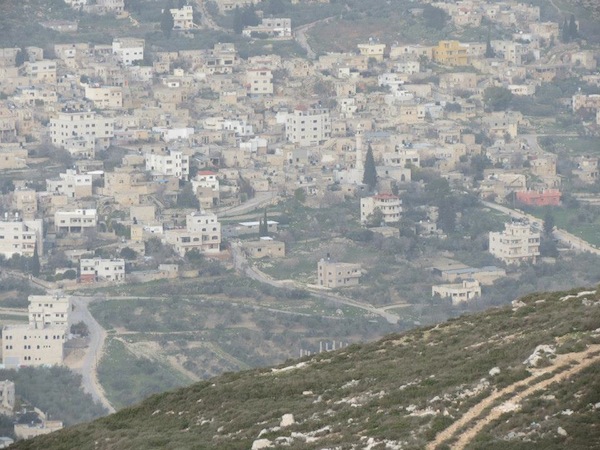
Baruch makes me feel foolish. He speaks gently, and sometimes it is difficult for me to hear his hushed voice over the noisy engine of his tiny, cluttered car. Nothing in the way he speaks reveals even the slightest bit of anger or resentment toward the residents of Awarta or Palestinians in general.
“There is peace here,” Baruch says to our astonishment. “The Palestinians here are tired of fighting, especially after the Second Intifada. They are slowly turning bourgeois.”
“But is there any interaction between the settlers and the Palestinians of Awarta? Is there cooperation between the two?” Yuval asks.
“Very little,” he answers candidly. “Sometimes the Jews will come down and fill up gas here because it’s cheaper. But cooperation? The Jews wouldn’t allow it.”
As we make our way up the steep, windy road to Yitzhar, Baruch tells us a story of a settler from Yitzhar who was patrolling in the area but went a little too far, until he found himself in the neighboring Palestinian village of Burin. Upon catching sight of the settler, several of the village youth started throwing rocks at him. The settler then shot and seriously wounded one of the Palestinians. An IDF soldier caught the act from a nearby observation tower, although it took the security services nearly half a year to find out just who did it, since none of the settlers of Yitzhar would cooperate with the investigation. Eventually, the shooter was put on trial and acquitted. “Lovely,” I say to myself quietly. Baruch proposes he pick us up and drive us to Havat Gilad in an hour. We politely accept.
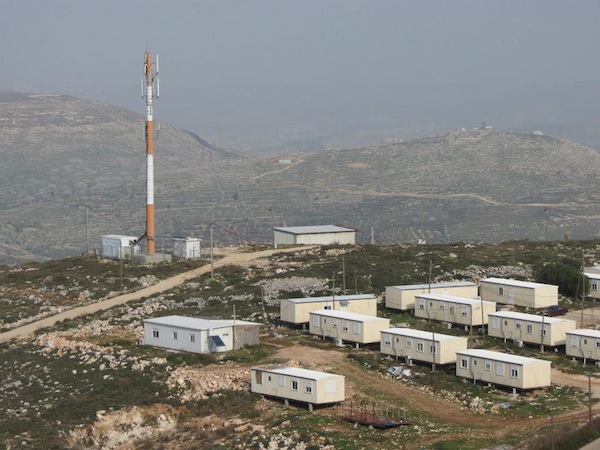
We don’t stay long in Yitzhar, but we are there long enough to drink coffee and eat cake at a local café owned by a lovely grandmother type. We sit near a table of people who sound like foreign dignitaries. “Norwegians, friends of the settlement,” their host tells us sternly. Our very presence clearly arouses his suspicion. Our appearance screams Tel Aviv leftists. Yuval writes an update on Facebook while I stare down at the coffee.
Yitzhar is the place I most wanted to visit, but all we find there are rows of awkwardly built, non-uniform houses. Children mill about, near the local elementary school. Some of the young ones approach us and ask where we are from. When we tell them we’re from Tel Aviv, they ask us if we have any money to give.
Uninvited
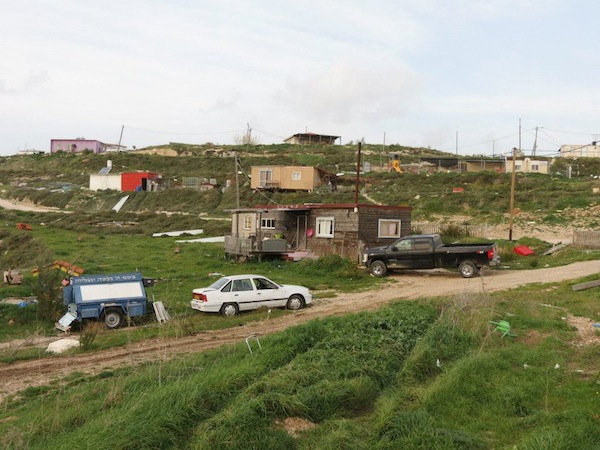
The ride to Havat Gilad takes all but 15 minutes. Down the steep, windy road from Yitzhar, we pass Burin and stay south of Nablus on Route 60. Baruch makes more small talk with us. After some prodding, he tells Yuval that he self-identifies as a “sort of anarchist” who doesn’t like when people put themselves in a position of hierarchy. Baruch adds that he voted for Naftali Bennett’s Jewish Home party in the last elections, mostly because he thinks the extreme right parties like Michael Ben-Ari’s Otzma L’Israel focus too much on the Palestinian issue. For him, the conflict with his neighbors is something that shouldn’t take up so much of the government’s energy.
Baruch says he can’t be seen with us, adding gently that the people of the outpost are already suspicious of outsiders, and that associating with us may get him in trouble. He drops us off about 200 meters before the entrance – the rest, he says, we have to walk.
We are clearly unwelcome here, I tell Yuval as we pass the outpost’s electric sign, which flashes updates of the settlement happenings for its residents. “Wednesday: Gardening Workshop,” I read the bold, electric letters aloud, laughing nervously. From the moment we enter Havat Gilad, which consists of a smattering of caravans situated on a small range of green hills, we cannot wait to leave. I do my best to avoid the stares of the residents. One woman even drives up to us in her minivan, inquiring as to our presence there. If only Baruch had stayed with us, I think as I imagine myself the victim of the same settler violence I have read about countless times. We stay long enough to snap a few photos of the beautiful, caravan-speckled surroundings before leaving. Baruch was right about not wanting to enter with us, I tell Yuval, who takes one last photo of the Meir Kahane poster hung from the makeshift bus stop at the entrance to the outpost before we head back to Route 60 on foot.


